Tuesday 30 November 2010
Barbary Ground Squirrel - Rodent with Refined Tastes
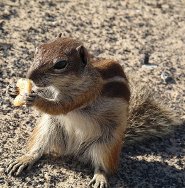 Barbary Ground Squirrel
Barbary Ground Squirrel (
Atlantoxerus getulus) has a head and body length measures 160 - 220 mm (6.3 - 8.7 in) and their tails are proportionately larger measuring 180 -230 mm (7.1 - 9.1 in). They are recognized by their white stripes down both sides or their body and sometimes one stripe that runs straight down the back. Their fur is much like other squirrel species being short and stiff. They are precocious mammals who do not let their miniature stature, weighing a mere 300 -350 g (10.6 -12.3 oz), keep them from making their presence known in their habitats. They are easily seen and forage for food in the daytime hours.
These squirrels are unique in that they have refined food preferences. They are omnivores, but their favorite snack is the rich olive-like fruit off the Argan tree which is native to Morocco. They have also been reported to eat the fruit of this tree and even apples out of the hands of tourists to the region. Barbary Ground Squirrels are photographed often when they seem to pose for their guests seemingly unafraid of people. These squirrels have become an invasive species in some places due to the lack of predators.
The species is plentiful in
Morocco,
Algeria, the
Western Sahara, and other countries off the north-western coast of Africa. They can be found in subtropical climates including tropical dry shrub land and rocky areas of temperate grassland. Burrowing is the favored way to build nests, but they also seem quite comfortable making dens in large groups of rocks. Their families become large when they are established in an area as they breed twice a year and have around 4 pups per litter. This breed of squirrel’s young grow up rather quickly and start families of their own. They have been introduced to other places throughout the world like the Canary Islands where it was introduced in 1965 as a pet to Fuerteventura Island (For an interesting, yet scientific read, go to
this paper on the matter). The squirrels are surprisingly intelligent and outwit would-be predators a lot of the time.
Picture of the Barbary ground squirrel by GanMed64, licensed under
Creative Commons Attribution 2.0 Generic license.
You can help spreading the word about this animal by liking it on facebook
Permanent Link
Monday 29 November 2010
Western Barbastelle Bat - Killing Moths Softly with its Song

The
Western barbastelle (
Barbastella barbastellus) is a unique European
bat, notable not only for its wide, forward-facing ears which are connected across its forehead - the "unibrow" of the bat world, so to speak - but also for its singular way of sneaking up on the moths that make up the majority of its diet. Like all bats, barbastelles use echolocation to navigate in flight, emitting high-frequency sounds that bounce off objects and echo back to them, indicating relative position. Unlike other bats, however, the barbastelle’s call is so soft that their prey, which are primarily moths, don’t hear them coming until they’re just about 10 feet away. By comparison, eared moths can hear the echolocation calls of most other bats when they’re about 100 feet away.
Barbastelles are of medium size, typically between 40 to 55 mm long, or 1-1/2 to 2-1/3 inches, not counting its large tail, which, at between 36 to 52 mm (about 1-1/2 to 2 inches) is nearly the length of its body. Their average weight varies between 6 to 13 grams, or about 1/5 oz. to just under 1/2 oz., and the females are larger than the males. Typical wingspans run about 245 mm to 300 mm, or 9-1/2 to nearly 12 inches. Their colors are dark brown to black, and as they mature their fur becomes lighter at the outer tips. This "frosting" of the hairs tends to appear in clusters on their throat and upper chest; in fact, their name originated from the Latin words meaning "star beard."
Though the barbastelle has developed a remarkable evolutionary trait in its ability to quietly hunt prey, it’s a relatively rare species, its population having dwindled due to causes thought to be related both to deforestation and the widespread use of insecticides. In 2008, the most recent assessment, this species was classified as Near Threatened by the International Union for Conservation of Nature (IUCN).
These bats can be found in southern England and areas in Italy, Germany, Norway, Switzerland and other parts of Europe. Their favorite habitats are in older forests, in hollow, loose-barked or storm-cracked trees. Some can be found roosting in caves and even in spaces under residential roofs and near cellars. When hunting, they prefer to fly about 10 to 20 feet above the ground - relatively low in bat terms - because their uniquely soft echolocation calls don’t travel as great a distance as those of their louder bat brethren.
You can help spreading the word about this animal by liking it on facebook
Permanent Link
Friday 26 November 2010
Eurasian Harvest Mouse - Miniature Master of Camouflage
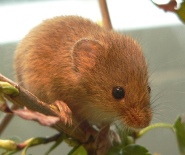
The
Eurasian harvest mouse (Micromys minutus) is nature's miniature master of camouflage. Though tiny, it's a slow-moving mouse, and it has many predators, among them
owls, foxes, cats, and weasels. When the mouse feels under threat, it adopts a defensive posture by remaining motionless, effectively camouflaging itself against the backdrop of its surroundings.
The Eurasian harvest mouse is widely distributed over Europe and Asia. Since this little mouse is remarkably adaptable and can be found in Great Britain, throughout Russia, and all the way to Japan, it isn't considered endangered. Micromys minutus thrives in many types of habitats, from grasslands and wetlands to bamboo stands. If human development encroaches on its natural habitat, this little mouse can make its home in people's gardens or even in drainage ditches.
An adult Eurasian harvest mouse weighs from 5-9 grams (.176-.316 ounce) and reaches a length anywhere from 50-70 mm (2-2.75 inches). Its body is covered in thick, soft fur, which is buff or reddish-brown in color. The mouse has a naked tail, roughly the same length as its body. The tail is semi-prehensile and allows the mouse to easily climb grass stalks and find seeds to eat.
The Eurasian harvest mouse's diet, like its range and habitat, is varied. Its primary fare is grass, seeds, and berries, but in summertime, it eats insects and larvae and sometimes feeds on fungi and moss. It likes to feed in cornfields as well, but farmers don't worry too much about its impact. The mouse doesn't eat enough vegetation to cause major problems, and it actually helps out farmers by eating insects that damage crops.
A round-the-clock rodent, the Eurasian harvest mouse is active throughout the day and night on three-hour cycles. It spends half an hour eating, then it sleeps for the remainder of its cycle. In winter, Eurasian harvest mice don't hibernate. They either build nests out of shredded grass or they congregate in barns or grain silos.
The female Eurasian harvest mouse gives birth to her litter in grass nests constructed approximately 100 cm (39 inches) aboveground. Baby mice that are only three days old can already hang onto grass stalks. The lifespan of Micromys minutus in the wild is short. They're lucky to make it to eighteen months old, and many only make it to six months. In captivity, however, these tiny mice have lived to be five years old.
Picture of the Eurasian harvest mouse by Hendrik Osadnik, licensed under
GNU Free Documentation License and
Creative Commons Attribution-Share Alike 3.0 Unported license.
You can help spreading the word about this animal by liking it on facebook
Permanent Link
Thursday 25 November 2010
Arctic Tern: a Frequent Flyer
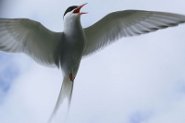
The
Arctic Tern (
Sterna paradisaea) is a seabird that can be found throughout the Arctic and the sub-Arctic areas of North America, Asia, and Europe. The species has quite the migration pattern, traveling all the way from the Arctic areas to the oceanic areas of Antarctica and back. This means that the bird travels 70,900 kilometers a year, or 44,300 miles. This is much larger than the migratory pattern of any other animal known to mankind.
One interesting thing about the animal is the fact that it performs almost all of its tasks while in the air. Most of the time it is either flying or gliding. Some groups have a different mating cycle than others. The Arctic Tern nests every one to three years. It nests in the arctic, and once its nesting period comes to an end it once again flies south.
The Arctic Tern is about average in size in comparison with other birds. They are between 33 and 39 centimeters in length, which is 13 to 15 inches. Their wings span a distance of 76 to 85 centimeters, or 26 to 30 inches. For the most part, they have gray and white feathers, while their beaks and feet are a more colorful red. The neck and bottom of the bird are pure white, while the top is typically gray, and the top of the head is black.
They are also known to live very long. Many of them reach the age of thirty. Most of the foods that they eat are fish and various shellfish. The species is also quite populous, with about a million members. The overall population changes as a result of environmental impacts are not known, but there has been a decrease in the numbers of Arctic Terns found in the southern regions.
Arctic Terns are monogamous, mating for life. In most cases, an Arctic Tern will return to the same colony every year. The courtship ritual is quite strenuous, especially when it first occurs. It begins when a female will chase a male to a high altitude to test their agility. The male will then begin to find fish for the female. On the ground, the courtship ritual involves strutting with wings lowered and tail raised. The
birds will then fly circles around one another. Once they have chosen each other, they then choose a nesting area. Both parents defend the nest.
Picture of the Arctic tern protecting nest near Markarfljot river in south Iceland, by OddurBen, licensed under
Creative Commons Attribution-Share Alike 3.0 Unported license.
You can help spreading the word about this animal by liking it on facebook
Permanent Link
Tuesday 16 November 2010
West Caucasian Tur - Mountain Goat Or Antelope?
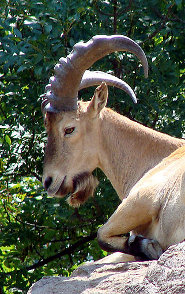
The
West Caucasian tur (
Capra caucasica) is a goat antelope that can be found in the western portion of the Caucasus Mountains, primarily in Russia and Georgia. This large, horned animal has features that are similar to goats, sheep, and antelope. The population of the species is approximately 5000.
The West Caucasian tur has two different coats for cold and warm seasons. The winter coat is a dull, gray-brown, and the summer coat becomes a deeper rusty gray. The undercoating of the animal is yellow, and the legs are dark. The Caucasian tur has distinctive horns which are deeply ridged and shaped like a broad-tipped sword. Males are bigger than females and have larger horns which can grow as long as 70 centimeters (28 inches). Males typically weigh between 65 and 80 kilograms (140 and 176 pounds), while females weigh between 50 and 60 kilograms (110 and 132 pounds). Males are also taller than females and grow to be about 110 centimeters (43 inches). Females grow to approximately 90 centimeters (35 inches).
The range of the West Caucasian tur is found in the Caucasus Mountain region and is no longer than 30 kilometers. The animals inhabit regions that are located between 800 and 4000 meters above sea level. Caucasian turs prefer forest-filled, snowy slopes, and males seek out higher altitudes than females do.
West Caucasian turs are nocturnal, so they travel and forage for food during the late evening, nighttime, and early morning hours. Females travel in herds of ten, but the males often remain solitary. The size of the herd grows in the winter time, and the female group may double in size. A herd can travel up to 20 kilometers a day, but this amount lessens in the cold weather. The diet of the Caucasian tur consists of a large variety of plants and grasses. In the winter, the animals graze on evergreen trees, and they seek out salt licks during all seasons. Caucasian turs breed from November to early January, and females give birth between May and July. The young are born within site of the herd and begin to travel with the group almost immediately.
The West Caucasian tur is considered an endangered species because of the trend in population decline. Numbers have significantly decreased by over 50 percent in the last twenty years. Caucasian turs can live to be fifteen years old, however most die by the age of ten. The main predators of the species are
lynxes and
wolves. Other causes of death include poaching, avalanches, and habitat loss.
Picture of the West Caucasian Tur by Dmano, licensed under
Creative Commons Attribution-Share Alike 3.0 Unported.
You can help spreading the word about this animal by liking it on facebook
Permanent Link
Friday 12 November 2010
Northern Royal Albatross - Romeo and Juliet
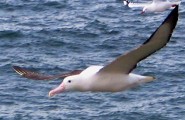
The
Northern Royal Albatross (Diomedea sanfordi) is a remarkable traveler, covering millions of miles over the Southern Ocean during a life span that can be more than 50 years. Yet the bird remains faithful to one mate for that same long life, and returns to the same nesting site for decades.
The Northern Royal Albatross is one of the largest seabirds, with an average adult being about 1.15 meters, or 3 feet, 9 inches, from beak to tail. They have an astounding wingspan of 3.2 meters, or 10 feet, 6 inches. The birds are white, with black on the top of the wings, and have pale pink bills with a black edge on the upper beak section.
The Northern Royal Albatross lives in the Southern Hemisphere. Its major breeding grounds are in the Chatham Islands, a remote archipelago east of New Zealand. When not raising chicks, they spend up to a year gliding the high air currents over the Southern Ocean, not touching the ground for months on end. The major portion of their diet is squid and fish, which they catch and consume on the wing.
The Royal Northern Albatross is very long lived, with the oldest birds reaching over 60 years old. They pair for life, meeting at the same nesting site for each breeding season. They have a two year breeding cycle; a single egg is laid in mid-November to mid-December, late spring to early summer in the southern hemisphere. The chick is not ready to leave its parents until the following October, and the adults then spend the next year traveling and eating before meeting again.
The Northern Royal Albatross has no natural predators, but
ferrets and cats, introduced into the islands where the birds nest, take eggs and kill chicks. When over the oceans, the birds frequently tangle themselves in fishing equipment while trying to catch fish.
The Northern Royal Albatross is an endangered species. The bird has a very small breeding range, and in the 1980s major storms degraded that habitat, making parts of it unsuitable for use by the birds and the number of chicks raised successfully crashed. Because they breed so slowly, the effects of that crash will last for decades. Recent indications are, however, that the population has stabilized more quickly than expected. Biologists are now cautiously optimistic that this magnificent bird will be a part of the Southern Ocean ecosystem for a long time to come.
Picture of the Northern Royal albatross by XLerate, licensed under
Creative Commons Attribution-Share Alike 3.0 Unported license.
You can help spreading the word about this animal by liking it on facebook
Permanent Link
Wednesday 10 November 2010
White-footed Dunnart
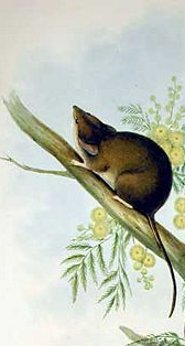
The
White-footed Dunnart (
Sminthopsis leucopus) is perhaps the least known of all the dunnarts. As marsupials, most dunnarts are found all throughout Australia, but the White-footed Dunnart is rarely observed. Easily mistaken for a mouse, this small, carnivorous creature is endemic to most of Tasmania, and the southeastern coast of mainland Australia.
Almost identical to the Common Dunnart, the White-footed Dunnart thrives in woodlands, grasslands, coastal forests, and dune vegetation. Unlike the Common Dunnart, its hind feet are striated, and its deep ear notches, furry brown tail, and long, narrow face distinguish it from a house mouse. Brownish-gray fur covers most of its body, excluding the off-white belly, and its dark, protruding eyes resemble tiny black marbles. Normally larger than females, males average 26 grams (9/10 ounces) in weight, with females averaging 19 grams (2/3 ounces), and maximum body length reaches 11 centimeters (4 1/3 inches); their tails are slightly shorter, reaching 9 centimeters (3 1/2 inches).
White-footed Dunnarts are highly nocturnal, most active in the first few hours after sunset, and will eat a wide variety of invertebrates, mostly insects; they will feed on the occasional small reptile, however, such as skinks. Mostly terrestrial, they inhabit a variety of landscapes, including clay loams, coarse sand, and thick patches of heath; occasional tree-climbing has also been observed. They will often make bark nests inside rotting logs or under wood piles, and some will burrow in the ground.
After mating in the summer, female White-footed Dunnarts give birth in September or October, and up to ten joeys may be delivered. As semelparous creatures, the male will die shortly after the litter is born, and the female will not reproduce again either. At eight weeks old, the young exit their mother's pouch, continue nursing for an additional month, then disperse.
The White-footed Dunnart's total population is equally divided between Tasmania and the mainland, although accurate figures are elusive; the current estimate is less than 10,000 adults. Despite extensive surveys, this animal is rarely observed, and various factors contribute to its population decline. It is presently listed as "vulnerable", with logging, land clearing, and careless burning regimes diminishing its natural cover. This has led to increased predation by foxes, along with domestic cats and dogs. With mostly sparse, scattered populations, their genetic diversity is at risk, and human intervention, possibly through captive breeding, will likely be necessary in promoting the White-footed Dunnart's recovery.
You can help spreading the word about this animal by liking it on facebook
Permanent Link
Tuesday 09 November 2010
Acacia rat - The tree-dwelling rat
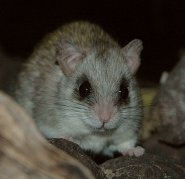
When most people think of rats, they picture hordes of rats running down crowded city streets, running into sewers or a hole in the wall, or scurrying into gutters. But the
Acacia rat (Thallomys paedulcus) is not your average rat. It is a tree-dweling rat that lives in the hollows or forks of Acacia trees. It is a pretty, semi-exotic grey rat with dark fur around its eyes, with a white chin, underside and feet. Their bodies are between 4 and 6 inches or 101.6 and 152.4 mm long, and their tails are between 5 and 8 inches or 127 and 203.2 mm long. The average weight of an adult rat is 1 pound or approximately 453.59 grams.
Acacia rats are found in subtropical or tropical dry shrublands such as Kenya, Ethiopia, Mozambique, Namibia, South Africa, Swaziland, Tanzana, Zambia, Zimbabwe, Botswana, and the Democratic Republic of the Congo. They live mainly on leaves, buds and gum from the bark of Acacia trees, as well as berries, roots and insects. They have many predators, such as snakes,
birds, and wild cats.
Currently, this species is listed as least concern on the IUCN Red List of Threatened, which means that it is widespread and abundant. However, Acacia trees in southern Africa are being harvested in abundance and may eventually cause the Acacia rat’s endangered status to be raised.
The female rat, or doe, generally gives birth to between two and four babies per litter. The life span of the Acacia rat has not been extensively studied. Although they are not often seen in pet stores, they are sometimes kept as pets. Owners report them as living between two and three years.
Acacia rats are said to make intelligent and fun pets. Like other breeds of rats, they are social and should live in pairs or groups. They are avid chewers and must be kept in metal or glass cages as they will chew through wood or plastic. If kept as a pet, Acacia rats need a large cage, both in width and height. They love to climb on branches and ropes, and their antics are great fun to watch, especially late at night when they are most active.
Picture of the Acacia rat by Marcel Burkhard, licensed under the
Creative Commons Attribution-Share Alike 2.0 Germany license.
You can help spreading the word about this animal by liking it on facebook
Permanent Link
Monday 08 November 2010
Bare-tailed Woolly Opossum
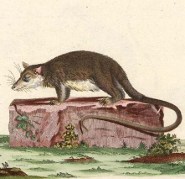
The
Bare-tailed woolly opossum (
Caluromys philander), is a mammal aptly named for its hairless, prehensile tail.
Native to Bolivia, Brazil, French Guiana, Guyana, Suriname, Trinidad and Tobago, and Venezuela, the Bare-tailed woolly opossum is primarily found in arboreal habitats, usually neotropical forests. This nocturnal animal spends its days resting in the canopy of trees, constructing leaf nests in tree hollows, and foraging at night for food.
The Bare-tailed woolly opossum is a New World marsupial, not to be confused with the Australian marsupial, although both are in the same subclass. The woolly opossum weighs in at less than two-thirds of a pound (.29 kg) and averages eight inches (20 cm) in length. Its tail can be twice as long as its body.
When it comes to diet, Bare-tailed woolly opossums will eat any fruit or flower that they can find. These “food opportunists” will select plants based on availability, rather than nutritional value, and will forage through the canopy of trees looking for easy plants to eat. To grasp a hard-to-reach fruit, the woolly opossum sometimes hangs by its long tail. They also eat seeds, insects, and small invertebrates.
Despite a life span of only three years, breeding does not begin until the female is at least one year old. Gestation is short, usually 14 days or less, with young born premature. An average litter size is four to six. Females can have up to three litters per year but this greatly depends on the availability of food. The less food sources, the less litters per year. The young remain in the mother’s pouch for about 80 days before beginning a nursing phase for an additional month. Although the Bare-tailed woolly opossum is a solitary creature, rarely interacting with its own species, the mother foregoes her usual nocturnal activities to nurse her young. Young are then ready leave the nest at about 130 days of age.
Due to a relatively stable population, the Bare-tailed woolly opossum is not considered endangered. However, its population is decreasing.
You can help spreading the word about this animal by liking it on facebook
Permanent Link
 Barbary Ground Squirrel (Atlantoxerus getulus) has a head and body length measures 160 - 220 mm (6.3 - 8.7 in) and their tails are proportionately larger measuring 180 -230 mm (7.1 - 9.1 in). They are recognized by their white stripes down both sides or their body and sometimes one stripe that runs straight down the back. Their fur is much like other squirrel species being short and stiff. They are precocious mammals who do not let their miniature stature, weighing a mere 300 -350 g (10.6 -12.3 oz), keep them from making their presence known in their habitats. They are easily seen and forage for food in the daytime hours.
Barbary Ground Squirrel (Atlantoxerus getulus) has a head and body length measures 160 - 220 mm (6.3 - 8.7 in) and their tails are proportionately larger measuring 180 -230 mm (7.1 - 9.1 in). They are recognized by their white stripes down both sides or their body and sometimes one stripe that runs straight down the back. Their fur is much like other squirrel species being short and stiff. They are precocious mammals who do not let their miniature stature, weighing a mere 300 -350 g (10.6 -12.3 oz), keep them from making their presence known in their habitats. They are easily seen and forage for food in the daytime hours.
 The
The  The
The  The
The  The
The  The
The  The
The  When most people think of rats, they picture hordes of rats running down crowded city streets, running into sewers or a hole in the wall, or scurrying into gutters. But the
When most people think of rats, they picture hordes of rats running down crowded city streets, running into sewers or a hole in the wall, or scurrying into gutters. But the  The
The